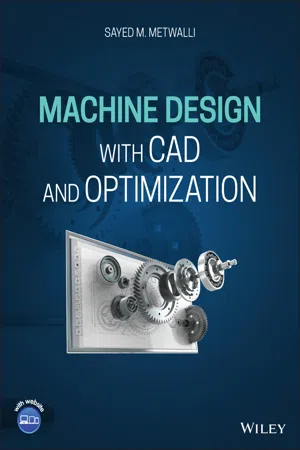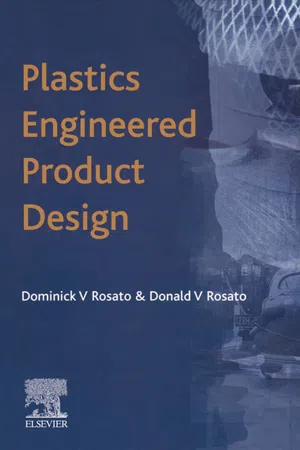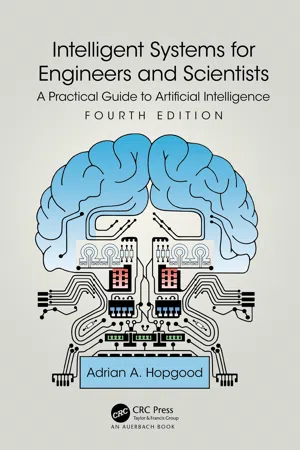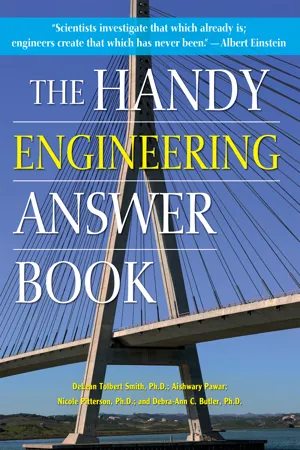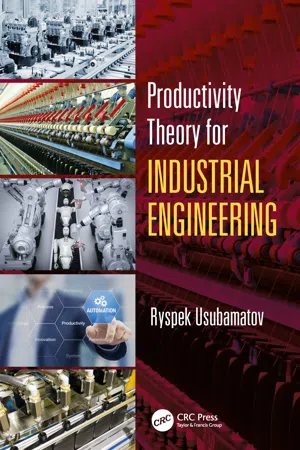Technology & Engineering
Machine Design
Machine design involves the process of creating new machines or improving existing ones to meet specific requirements. It encompasses various engineering disciplines such as mechanical, electrical, and industrial engineering to design machines that are efficient, reliable, and safe. This process involves conceptualizing, modeling, prototyping, and testing to ensure that the machine meets its intended purpose.
Written by Perlego with AI-assistance
Related key terms
7 Key excerpts on "Machine Design"
- eBook - ePub
- Sayed M. Metwalli(Author)
- 2021(Publication Date)
- Wiley(Publisher)
1 Introduction to DesignA design is understood to be an object that fulfils a function or performs a job. Different designs can be of objects other than machines. In engineering, design can be associated with different fields of engineering such as bridges and highways in civil engineering; ship design in marine engineering; electric motors, computers, and communication equipment in electrical and electronic engineering; and so on. In mechanical engineering, Machine Design, engines, turbines, pumps, and heating or cooling systems are some of the main areas of mechanical design. Machine Design, however, can be defined as the process of getting the design of a machine and its components. The design of a machine can be understood as the machine form and construction as an object that is made to perform the function of the machine. The machine is generally a device composed of moving parts to perform a function that consumes or transforms power or energy. A motorcycle or a vehicle is a machine that transforms energy into moving a person or persons from one point to the other and consumes energy generated by the engine or the motor to do so. The consumed energy is spent mainly in overcoming air and ground resistances, acceleration and deceleration, and potential energy for different elevations up or down if no regenerative mean is present. Figure 1.1 shows an example of a trans-mixer design that transports concrete from a mixing station to a construction site. The truck carrying the mixer consumes power in continuous rotation and in transporting the concrete charge over the roads to the construction site. A separate power is usually used to keep the mixer drum continuously rotating during transit, accelerations and decelerations, and pouring the concrete into the desired location (Badawy et al. 1994 ). The machine tool is another design of a complex device consuming energy in producing components by machining or other manufacturing processes. A mechanism - eBook - ePub
- D.V. Rosato, D.V. Rosato(Authors)
- 2003(Publication Date)
- Elsevier Science(Publisher)
5COMPUTER-AIDED DESIGN
Technology overview
Computer technology requires a completely different methodology of engineering design. It has revolutionized the speed and efficiency of the plastic design functions. The more the entire design function is studied, the more repetitive tasks are uncovered in that function. The computer’s ability to perform these tasks untiringly and with blazing speed is the basis for these productivity gains.The computer continues to provide the engineer with the means to simplify and more accurately develop a design timewise and costwise. It provides a better understanding of the operating requirements for a product design, resulting in maximizing the design efficiency in meeting product requirements. The computer is able to convert a design into a fabricated product providing a faster manufacturing startup. Other benefits resulting from the computer technology include (1) ease of developing and applying new innovative design ideas, (2) fewer errors in drawings; (3) good communications with the fabricator, (4) improved manufacturing accuracy; and (5) a faster response to market demand.Many of the individual tasks within the overall design process can be performed using a computer. As each of these tasks is made more efficient, the efficiency of the overall process increases as well. The computer is suited to aid the designer by incorporating customer inputs, problem definitions, evaluations, and final product designs.Computer-aided design (CAD) uses the mathematical and graphic-processing power of the computer to assist the mechanical engineer in the creation, modification, analysis, and display of designs. Many factors have contributed to CAD technology becoming a necessary tool in the engineering world, such as the computer’s speed at processing complex equations and managing technical databases. CAD combines the characteristics of designer and computer that are best applicable to the design process. - Winston A. Knight, Geoffrey Boothroyd(Authors)
- 2019(Publication Date)
- CRC Press(Publisher)
13 Design for Machining13.1 Introduction
Many techniques are available to reduce manufacturing costs and increase manufacturing productivity. These measures include using:- Improved materials, tools, and processes
- More effective organization and factory layout, materials handling, and assembly techniques
- Automation, wherever it contributes to greater efficiency
Unfortunately, designers often consider that their job is to design the product for performance, appearance, and possibly reliability, and that it is the manufacturing engineer’s job to produce whatever has been designed. There is often a natural reluctance to change a proven design for the sake of a reduction in manufacturing cost, and although designers generally assert that they take manufacturing problems into account whenever possible, the fact is that as a subject, design for manufacture is hardly recognized compared with design for performance. Sometimes design for manufacture is mentioned briefly in textbooks on manufacturing, but only rarely is it mentioned in textbooks on design.Many companies ensure that their designers obtain some manufacturing experience, and many university engineering programs include courses in manufacturing. All this is beneficial, but design for manufacture is one of those subjects a person is expected to assimilate through experience rather than learn from a textbook or instructor. This chapter explains one important aspect of this subject: design for machining.For obvious reasons machining is a wasteful process, and many engineers feel that the main concern should be to design components that do not require machining. Since 80 to 90% of manufacturing machines are designed to machine metal, the view that machining should be avoided must be considered impracticable for the immediate future. However, the trend toward the use of “near net shape” processes that conserve material is clearly increasing, and when large-volume production is involved, this approach should be foremost in the designer’s mind.- eBook - ePub
- Neill Hughes(Author)
- 2013(Publication Date)
- Crowood(Publisher)
1 Computer-Aided Design and Manufacture What aspects of design and workshop manufacturing can computer software help with? This chapter aims to answer this question by clarifying established methods for product or engineering design, discussing the role of computer-aided techniques in those methods, and providing an overview of CAD technology. WHAT IS DESIGN? The word ‘design’ has a range of meanings, and the following sub-sections cite several definitions, each similar and complementary. Considering all of them may help you to develop your own understanding of what design means. The dictionary definition: The Hugo English Pocket Dictionary defines ‘design’ as a verb, meaning to plan out, intend, make, invent or pattern, and as a noun, meaning an intention, a plan, a purpose or a decorative pattern. Bettina Von Stamm’s definition: Bettina Von Stamm, a recognized expert in the field of design and innovation management, presented three definitions of design in her book Managing Innovation, Design and Creativity: ♦ Design is the tangible outcome – that is, the end product such as cameras, cars, and so on ♦ Design is a creative activity ♦ Design is a process by which information is transformed into a tangible outcome In her discussion of the definition of design Stamm emphasizes design as being a conscious decision-making process, and presents this explanation: ‘Design is the conscious decision-making process by which information (an idea) is transformed into an outcome, be it tangible (a product) or intangible (a service).’ The UK-SPEC definitions: In the UK, the definition and recognition of professional competencies in engineering is managed by the Engineering Council: they define what chartered engineers, incorporated engineers and engineering technicians should be able to do, and these definitions are summarized in a document called the UK-SPEC (United Kingdom Standard for Professional Engineering Competence) - eBook - ePub
Intelligent Systems for Engineers and Scientists
A Practical Guide to Artificial Intelligence
- Adrian A. Hopgood(Author)
- 2021(Publication Date)
- CRC Press(Publisher)
Chapter 13 Systems for Design and SelectionDOI: 10.1201/9781003226277-1313.1 The Design Process
Before discussing how intelligent systems can be applied to design, it is important to understand what we mean by the word design. Traditionally, a distinction is drawn between engineering design and industrial design:Engineering design is the use of scientific principles, technical information, and imagination in the definition of a mechanical structure, machine, or system to perform specified functions with the maximum economy and efficiency.(Fielden 1963 )Industrial design seeks to rectify the omissions of engineering; it is a conscious attempt to bring form and visual order to engineering hardware where technology does not of itself provide these features.(Moody 1980 )We will take a broad view of design, in which no distinction is drawn between the technical needs of engineering design and the aesthetic approach of industrial design. Our working definition of design will be as follows (Sriram et al. 1989 ):[Design is] the process of specifying a description of an artifact that satisfies constraints arising from a number of sources by using diverse sources of knowledge.Some of the constraints must be predetermined, and these constitute the product design specification (PDS). Other constraints may evolve as a result of decisions made during the design process (Pons and Raine 2005 ). The PDS is an expression of the requirements of a product, rather than a specification of the product itself. The latter, which emerges during the design process, is the design. The design can be interpreted for manufacture or construction, and it allows predictions about the performance of the product to be drawn.Different authors have chosen to analyze the design process in different ways. An approximate consensus is that the broadest view of the design process comprises the following phases (Figure 13.1 - eBook - ePub
- DeLean Tolbert Smith, Aishwary Pawar, Nicole P. Pitterson, Debra-Ann C. Butler(Authors)
- 2022(Publication Date)
- Visible Ink Press(Publisher)
Engineers use various types of drawings for designing and creating products and processes. Drafting is the creation of visual representations of products, processes, or systems. Drawings may be created electronically or by hand. When manufacturing parts for product development, drawings are used to communicate ideas, specifications, required materials, tools necessary, etc.What are machining and metal fabrication?Machining and metal fabrication entail the selection and use of machining tools.What are the four areas of manufacturing engineering?The Accreditation Board for Engineering and Technology, which is a governing body for all engineering and technology programs, has identified four key areas of manufacturing engineering. These are: 1) Materials and manufacturing processes; 2) Product, tooling, and assembly engineering; 3) Manufacturing systems and operations; and 4) Manufacturing competitiveness.HISTORYWhat is the history of manufacturing engineering?Manufacturing dates back to before the Industrial Revolution when prehistoric societies created instruments needed for daily living such as mechanisms for fetching water from watering holes and wells, clay pots, clay tablets, and paints as well as tools used for carvings such as the hieroglyphs found in Egypt and other ancient artifacts.What is the connection between the Industrial Revolution and manufacturing engineering?It was the Industrial Revolution that spurred the formalization of manufacturing engineering as a discipline. While small-scale manufacturing led to the creation of tools, machines, and everyday artifacts, it was the revolution that introduced more robust manufacturing processes that went beyond traditional methods such as casting and hammering. With the emergence of manufacturing industries came the ability to create more advanced items through the development of the factory system that we still have today.Who are the pioneers of manufacturing engineering?Several people pioneered the emerging discipline. Some key figures were Englishman Matthew Boulton (1728–1809) and Scotsman James Watt (1736–1819), who fabricated and assembled a steam engine and later went on to commercially produce them. American Eli Whitney (1765–1825) created a cotton gin that provided the opportunity to clean 50 pounds of cotton per day. Englishman Joseph Whitworth (1803–1887) developed measuring machines and standardized the system of uniform measures. It was Whitworth who created the system of uniform screw threads. Frederick W. Taylor is both an industrial and manufacturing engineering pioneer and is known for his invention of the Taylor–White process of creating high-speed cutting tools. Taylor’s work provided groundbreaking knowledge about the many aspects of cutting metal, which minimized error and led to more robust machining processes. - eBook - ePub
- Ryspek Usubamatov(Author)
- 2018(Publication Date)
- CRC Press(Publisher)
Production experience in manufacturing industries demonstrates that different machined work parts can be manufactured by having simple and complex technological processes. The complex and long technological process for machining the work parts is decomposed on definite number of workstations or machine tools that depend on the required productivity rate for the manufacturing system. The simple and short technological processes that cannot be decomposed, like stamping, coining, forging or others, but demand to increase productivity rate leads to parallel arrangement of such machine tools and workstations. Hence, workstations or machine tools can be arranged in the parallel, linear and mixed (parallel–linear) structures of manufacturing systems that depend on a necessary value of productivity rate and on the complexity of technological processes.Successful manufacturing system designs must be capable of satisfying the strategic objectives of production system. Main objectives of manufacturing systems design is high productivity of machinery and high quality of manufactured products.Manufacturing systems design is the process of defining the structure, components, modules, interfaces and data for a system that satisfy specified requirements for productivity. Systems design could be seen as the application of systems theory to product development. The manufacturing system design relates to the actual output processes of the system. This is laid down in terms of how data is input into a system, how it is verified, how it is processed and how it is displayed as manufacturing system design. The following are the requirements about how the system is decided:- Necessary productivity rate.
- Appropriate technology.
- Storage of products.
- System control and backup or recovery.
Productivity rate requirement is solved by intensification, segmentation and duplication of technological process. Processing requirements enable defining appropriate technological process, machine tools, workstations, transport system and structural design of production systems. Solving these problems simultaneously results in achievement of minimal cost and high quality of the product. Storage requirements are solving problems of machined parts store between machine tools, automated lines and workshops. System control and backup or recovery enables to keep the manufacturing system in workable conditions. Making these decisions in a way that supports high-level objectives of a manufacturing system requires an understanding of how design issues affect the interactions among various components of a manufacturing system.
Index pages curate the most relevant extracts from our library of academic textbooks. They’ve been created using an in-house natural language model (NLM), each adding context and meaning to key research topics.
